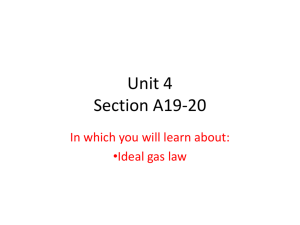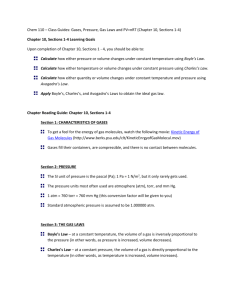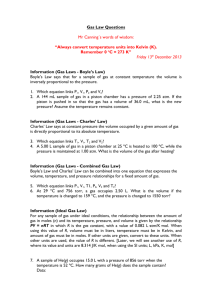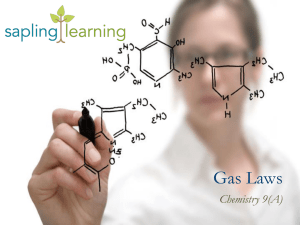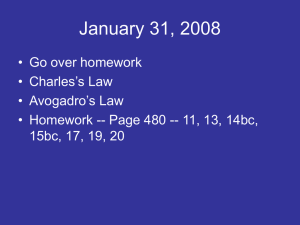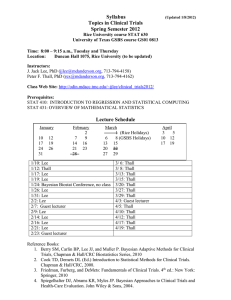doc
advertisement
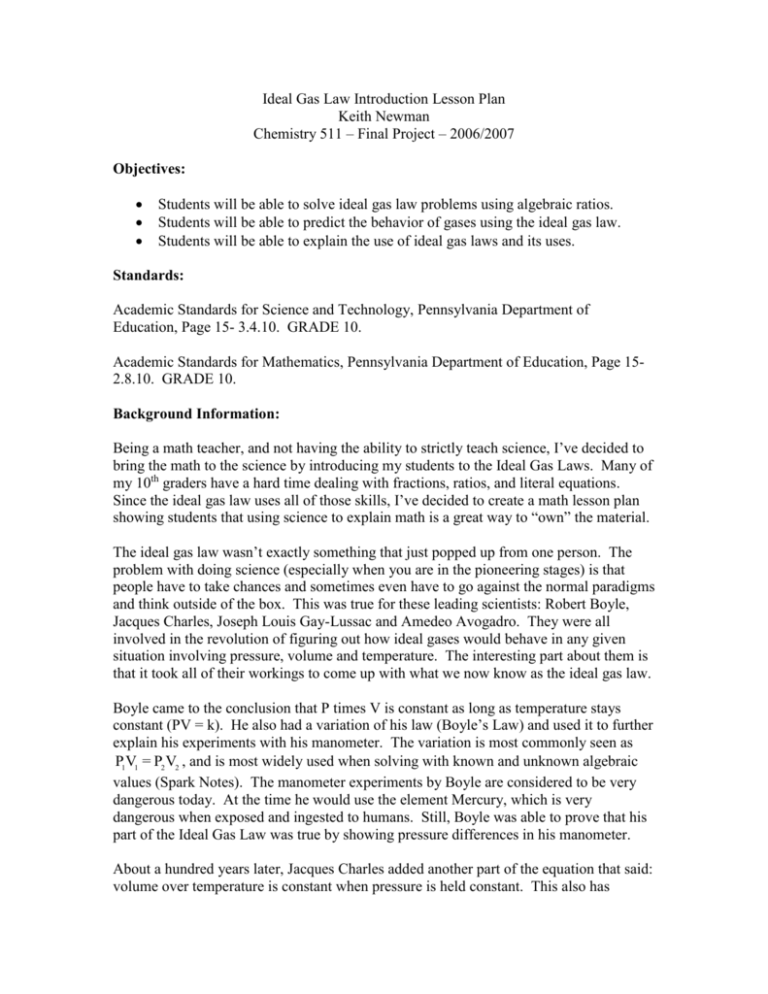
Ideal Gas Law Introduction Lesson Plan Keith Newman Chemistry 511 – Final Project – 2006/2007 Objectives: Students will be able to solve ideal gas law problems using algebraic ratios. Students will be able to predict the behavior of gases using the ideal gas law. Students will be able to explain the use of ideal gas laws and its uses. Standards: Academic Standards for Science and Technology, Pennsylvania Department of Education, Page 15- 3.4.10. GRADE 10. Academic Standards for Mathematics, Pennsylvania Department of Education, Page 152.8.10. GRADE 10. Background Information: Being a math teacher, and not having the ability to strictly teach science, I’ve decided to bring the math to the science by introducing my students to the Ideal Gas Laws. Many of my 10th graders have a hard time dealing with fractions, ratios, and literal equations. Since the ideal gas law uses all of those skills, I’ve decided to create a math lesson plan showing students that using science to explain math is a great way to “own” the material. The ideal gas law wasn’t exactly something that just popped up from one person. The problem with doing science (especially when you are in the pioneering stages) is that people have to take chances and sometimes even have to go against the normal paradigms and think outside of the box. This was true for these leading scientists: Robert Boyle, Jacques Charles, Joseph Louis Gay-Lussac and Amedeo Avogadro. They were all involved in the revolution of figuring out how ideal gases would behave in any given situation involving pressure, volume and temperature. The interesting part about them is that it took all of their workings to come up with what we now know as the ideal gas law. Boyle came to the conclusion that P times V is constant as long as temperature stays constant (PV = k). He also had a variation of his law (Boyle’s Law) and used it to further explain his experiments with his manometer. The variation is most commonly seen as P1V1 = P2 V2 , and is most widely used when solving with known and unknown algebraic values (Spark Notes). The manometer experiments by Boyle are considered to be very dangerous today. At the time he would use the element Mercury, which is very dangerous when exposed and ingested to humans. Still, Boyle was able to prove that his part of the Ideal Gas Law was true by showing pressure differences in his manometer. About a hundred years later, Jacques Charles added another part of the equation that said: volume over temperature is constant when pressure is held constant. This also has V1 V2 = (Spark T1 T2 Notes). Now, Charles knew that the temperature had to be the absolute temperature because he found that when you use Celsius you can have negative values and when you use negative values in his formula you can get negative volume and pressure which doesn’t make any sense. Therefore all temperatures we use will be in Kelvin units (absolute temperatures, C + 273) (Spark Notes). The problem with Charles is he didn’t really record his notes for use by others. He was very interested in ballooning and used his own discoveries to help him in his flights (E. Thall). another form just like Boyle’s Law and can be expressed such as: Gay-Lussac realized a third component of the ideal gas law (also several years after Charles figured this out) and said pressure over temperature is constant when volume is constant (D. Nelson). This was the key connection that became Charles’ Law because it’s the variation of what was said by Charles but now used to fit our ideal gas law. Since, we know where the P, V, and T come from in the laws talked about above but, what are the “n” and “R” values all about? We are using the widely accepted notion of Avogadro’s Law (the man who brought everything together into the basic Ideal Gas Law of PV = nRT) that states the volume of a gas kept at constant temperature and pressure will relate to the amount of moles of that gas are present (Wikipedia: Avogadro Article). This is where the “n” value comes from. It simply states we have “n” moles of this gas present. The problem with Avogadro’s Law wasn’t that it was flawed but, other scientists were not ready to accept the fact that the amount of molecules had anything to do with how ideal gases behave (E. Thall). The R value is simply how we handle unit conversions because we are going from moles, temperature, volume, and pressure units. In this lesson we will use liters for volume (L), atmospheres for pressure (atm), n will be in units of the mole (mol), and as mentioned previously, temperature is in Kelvin (K). Once they came up with the ideal gas law they had to create a constant “R” to keep the equation balanced in terms of units, basically a value that would basically convert all those different units. Since we are using the above L atm units our constant is going to be R = 0.08206 (Spark Notes). This will work out mol K very nicely algebraically once we are given our values to input. Classroom Activity: Students will now have direct instruction on how to use the ideal gas laws. This will include manipulating the ideal gas laws to solve for P, T, V, and n. Once we establish those three formulas algebraically, students can be given problems to solve for the unknown variable. Formulas to know: PV = nRT. From this ideal gas law, the following equations follow. nRT V= . Once all of the R units cancel out we are left in liters. P nRT P= . Once all of the R units cancel out we are left in atm. V PV T= . Once all of the R units cancel out we are left in Kelvins. nR PV n= . Once all of the R units cancel out we are left in moles. RT Sample Problems: Find the volume of 2.40 mol of gas whose temperature is 50.0 °C and whose pressure is 2.00 atm. Remember to change from Celsius to Kelvin! Find the pressure of 3.00 mol of gas whose temperature is 60.0 °C and whose pressure is 5.00 L. Find the temperature of 1.50 mol of gas whose pressure is 4.00 atm and whose volume is 7.50 L. Find the number of moles of a certain ideal gas whose volume, temperature, and pressure are 3.00 L, 25.0 °C, and 2.00 atm, respectively. Inquiry Process: After students have been practicing the ideal gas law problems they will be introduced to some inquiry questions that help them understand how varying values will change the equation. This helps their math inquiry skills by using inductive reasoning. Inquiry questions will be as a group assignment (groups were assigned in the beginning of the marking period based on student performances with each group have one high, one low and two intermediate achievers). 1. What happens to temperature if pressure goes up and volume remains the same? 2. What happens to temperature if pressure goes down and volume remains the same? 3. What happens to pressure if volume remains the same but temperature goes up? 4. What happens to pressure if volume remains the same but temperature goes down? 5. What happens to pressure if volume goes up and temperature remains the same? 6. What happens to pressure if volume goes down and temperature remains the same? 7. What happens to volume if pressure is held constant but temperature goes up? 8. What happens to volume if pressure is held constant but temperature goes down? Reflection: Students are required to turn in a one page journal reflection that details how their group went about answering the questions and what hardships they encountered. Students should also include a summary of what role members of the group took in evaluating these questions. The entry must also include a brief description on their understanding of the ideal gas law. If they are having difficulties with their own understanding of it, then they must detail what issues they are having problems with and a course of action to address those issues. Extension Questions: Why does a baseball bounce better in the summer than in the winter? What does a larger container do to pressure? I would also further the students extension with this activity from wikihow.com. This activity is fairly simple to demonstrate and is another real life demonstration of these formulas in action. WikiHow, Various (2007). Crushing a Can with Air Pressure Activity. http://www.wikihow.com/Get-Kids-Interested-in-Science-by-Crushing-a-Can-With-AirPressure Assessment: In addition to a standard computational exam, students will be given a set of problems similar to the ones found in the example set. With those problems, they must use the following Java based applet to determine the answers. They are to use screen captures using “Print Screen” function and written explanations to answer the questions. PhET Website (2007). Physics Education Technology website. http://phet.colorado.edu/web-pages/simulations-base.html Students can now “play” with the ideal gas laws in a Java based applet. This allows for students to visually see the numbers they are crunching as trapped gases and connects them even further to the content. Resources: Sparknotes, Uncredited (2007). Ideal Gas Law History and Equation Summary. http://www.sparknotes.com/chemistry/gases/ideal/summary.html Nelson, D. (2007). Lecture Notes PDF format. http://www.aos.wisc.edu/~dnnelson/AOS101_Lecture_3.pdf Wikipedia, Uncredited (2007). Avogadro’s Law. http://en.wikipedia.org/wiki/Avogadro%27s_law Thall, E. (2007). Thall’s History of Gas Laws. http://mooni.fccj.org/~ethall/gaslaw/gaslaw.htm PhET Website (2007). Physics Education Technology website. http://phet.colorado.edu/web-pages/simulations-base.html WikiHow, Various (2007). Crushing a Can with Air Pressure Activity. http://www.wikihow.com/Get-Kids-Interested-in-Science-by-Crushing-a-Can-With-AirPressure
